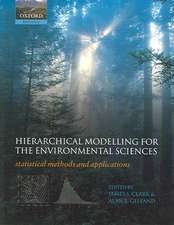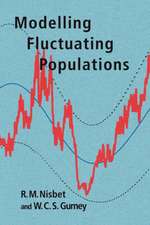Cultivating Biodiversity to Transform Agriculture
Editat de Étienne Hainzelinen Limba Engleză Hardback – 17 dec 2013
| Toate formatele și edițiile | Preț | Express |
|---|---|---|
| Paperback (1) | 639.41 lei 6-8 săpt. | |
| SPRINGER NETHERLANDS – 23 aug 2016 | 639.41 lei 6-8 săpt. | |
| Hardback (1) | 645.60 lei 6-8 săpt. | |
| SPRINGER NETHERLANDS – 17 dec 2013 | 645.60 lei 6-8 săpt. |
Preț: 645.60 lei
Preț vechi: 759.54 lei
-15% Nou
Puncte Express: 968
Preț estimativ în valută:
123.55€ • 127.64$ • 102.83£
123.55€ • 127.64$ • 102.83£
Carte tipărită la comandă
Livrare economică 25 martie-08 aprilie
Preluare comenzi: 021 569.72.76
Specificații
ISBN-13: 9789400779839
ISBN-10: 9400779836
Pagini: 275
Ilustrații: XIV, 261 p. 19 illus., 5 illus. in color.
Dimensiuni: 155 x 235 x 17 mm
Greutate: 0.56 kg
Ediția:2013
Editura: SPRINGER NETHERLANDS
Colecția Springer
Locul publicării:Dordrecht, Netherlands
ISBN-10: 9400779836
Pagini: 275
Ilustrații: XIV, 261 p. 19 illus., 5 illus. in color.
Dimensiuni: 155 x 235 x 17 mm
Greutate: 0.56 kg
Ediția:2013
Editura: SPRINGER NETHERLANDS
Colecția Springer
Locul publicării:Dordrecht, Netherlands
Public țintă
ResearchCuprins
Foreword.- Introduction.- 1. Biodiversity has always been at the heart of agricultural activity.- 2. The challenges of agricultural transformation.- 3. Intensifying ecological processes to transform agricultural performance.- 4. Agrobiodiversity, the main lever of this ecological intensification.- 5. Ecological intensification, a strategic priority for CIRAD.- 6. A book with six viewpoints.- 7. Bibliographical references.- Chapter 1 The diversity of living organisms: the engine for ecological functioning.- 1. Diversity and unity of living organisms: the successive revolutions of the biological sciences.- 2. A history closely linked to man’s.- 3. Documented risks of erosion of agrobiodiversity.- 4. Why ‘cultivate’ biodiversity?.- 5. What is the best way of understanding the extraordinary complexity of living organisms and agroecosystems?.- 6. Agrobiodiversity: a development issue?.- 7. Conclusion.- 8. Bibliographical references.- Chapter 2 From artificialization to the ecologization of cropping systems.- 1. The impasses in the artificialization of cropping systems.- 2. Opportunities and limitations of cropping systems that promote biodiversity.- 3. Towards new ‘ecologically innovative’ cropping systems.- 4. Conclusion.- 5. Bibliographical references.- Chapter 3 Rethinking plant breeding.- 1. Plant breeding: the past and the present.- 2. Recent changes and developments.- 3. The challenges of ecologically intensive agriculture.- 4. Mechanisms to help meet the challenges of ecological intensification5. Conclusion.- 6. Bibliographical references.- Chapter 4 Ecological interactions within the biodiversity of cultivated systems.- 1. Biodiversity and pest control.- 2. Hidden soil diversity: what potential for agriculture?.- 3. Biodiversity and agriculture-livestock interactions.- 4. Conclusion.- 5. Bibliographical references.- Chapter 5 Conserving and cultivating agricultural genetic diversity: transcendingestablished divides.- 1. History of the conservation of genetic resources in agriculture.- 2. International strategies and policies in favour of mobilizing genetic diversity.- 3. Need for in situ conservation and complementarities with ex situ conservation.- 4. Conclusion: hybridization or co-evolution of conservation models.- 5. Bibliographical references.- Chapter 6 Towards biodiverse agricultural systems: reflecting on the technological, social and institutional changes at stake.- 1. Co-evolution between technical dynamics and social dynamics: an analysis which starts upstream of agriculture.- 2. Recent changes in agriculture and food systems: market dynamics and new directions.- 3. Conclusion.- 4. Bibliographical references.- List of authors.
Notă biografică
Étienne Hainzelin, agronomist, has a doctorate in plant science. He has held several scientific positions in Côte d’Ivoire, Réunion, and several times in Brazil. Former Director of Research and Strategy at CIRAD, he is currently Adviser to the CEO of CIRAD. He is also a visiting professor at the University of Ottawa.
Textul de pe ultima copertă
Agriculture is the primary human activity: it involves 1.3 billion people, nearly a quarter of the world’s population and half of its labour force. The cultivated area, i.e., the area where humans plan and directly control the vegetation cover, now represents over 20% of the landmass. Faced with the challenges of demography and poverty, agricultural systems, in all their diversity, are being called upon to intensify and enhance the production of goods and services. At the same time, they are expected to be able to cope better with climatic and other risks and uncertainties. How can biodiversity contribute to the transformation of these agricultural systems? The diversity of living organisms has served agriculture since its origins in the Neolithic Era. But modern farming has aimed for ever increasing and consistent yields, relying on massive use of synthetic inputs and fossil energy to do so. Indeed, we seem to have forgotten how much plant, animal and microbial biodiversity are the engine of all production processes and the basis for the regulation of ecosystems, both cultivated and natural. We will have to understand biodiversity better, remobilize it, enrich it and plan it – in one word cultivate it – in order to intensify production in a sustainable manner and ensure global food security. This will put agriculture in the developing world at the centre of discussions on possible transformations of agricultural systems. This book approaches these issues from various angles and shows how these transformations are not limited to the plot and its crop but also concern the profound links between rural communities and their living heritage, their ways to conserve this agrobiodiversity and their innovative ways for benefitting from it.
This book is intended for a scientific audience, researchers and academics from across fields (ecology, genetics, social sciences, plant protection, agronomy, environment, rural development) as well as for thegeneral informed public.
Étienne Hainzelin, agronomist, has a doctorate in plant science. He has held several scientific positions in Côte d’Ivoire, Réunion and several times in Brazil. Former Director of Research and Strategy at CIRAD, he is currently Adviser to the CEO of CIRAD. He is also a visiting professor at the University of Ottawa.
Foreword by Gilles Boeuf, President, National Museum of Natural History, Paris and Full Professor, Pierre and Marie Curie University.
This book is intended for a scientific audience, researchers and academics from across fields (ecology, genetics, social sciences, plant protection, agronomy, environment, rural development) as well as for thegeneral informed public.
Étienne Hainzelin, agronomist, has a doctorate in plant science. He has held several scientific positions in Côte d’Ivoire, Réunion and several times in Brazil. Former Director of Research and Strategy at CIRAD, he is currently Adviser to the CEO of CIRAD. He is also a visiting professor at the University of Ottawa.
Foreword by Gilles Boeuf, President, National Museum of Natural History, Paris and Full Professor, Pierre and Marie Curie University.
Caracteristici
This book shows a possible reconciliation between biodiversity/environment conservation and productive agriculture This book approaches the issue of the transformation of agriculture from various angles This book is intended for a scientific audience, researchers and academics in the fields of ecology, genetics, social sciences, plant protection, agronomy, environment and rural development Includes supplementary material: sn.pub/extras















